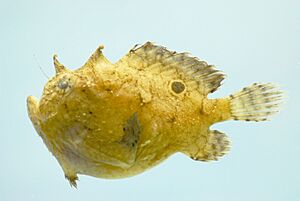Singlespot frogfish facts for kids
Quick facts for kids Singlespot frogfish |
|
|---|---|
 |
|
| Conservation status | |
| Scientific classification | |
| Synonyms | |
|
The singlespot frogfish, also known as the big-eyed frogfish, is a very interesting marine fish. It lives in the Western Atlantic Ocean. This fish is part of the frogfish family, which are known for their unique ways of catching food and their unusual appearance. Its scientific name is Fowlerichthys radiosus.
Contents
About the Singlespot Frogfish
How it Got its Name
The singlespot frogfish was first officially described in 1869 by an American scientist named Samuel Garman. He first called it Antennarius radiosus. Later, in 1941, another scientist, Thomas Barbour, described a similar fish. He gave it a new name, Fowlerichthys floridanus, and placed it in a new group called Fowlerichthys. It turned out that F. floridanus was actually the same fish as Antennarius radiosus. So, the name Fowlerichthys radiosus became the official one.
The name Fowlerichthys honors Henry Weed Fowler, an American fish expert. He gave Barbour the first example of the fish that helped define this group. The second part of the name, radiosus, means "rayed." This refers to its special "fishing rod" (called an illicium) being longer than that of some other similar fish.
What Does it Look Like?
The singlespot frogfish has a body that is a bit flattened from side to side and looks somewhat round. It has large eyes on the sides of its head and a big mouth that points upwards. Inside its mouth are many small teeth.
Its small gill openings are located behind and below its pectoral fin. This fin looks a bit like an arm with an elbow joint and is broadly connected to its body.
This fish has three special spines on its back. The first spine, called the illicium, is like a fishing rod. It's about the same length as the second spine and has a small, folded oval "lure" (called an esca) at its tip. The second spine isn't very curved and is connected to the skin on its head by a thin membrane. The third spine can move and is not connected to the skin.
The singlespot frogfish also has an anal fin with 9 soft rays. Its skin is covered with tiny, branched spikes. The fish is usually brown to beige in color. Its fins sometimes have stripes. The "fishing rod" often has pale bands. A cool feature is a single large eyespot on its upper body, near the base of its dorsal fin. It also has short dark lines that spread out from its eye.
These fish can grow to about 9.4 centimeters (about 3.7 inches) long. However, some reports suggest they can reach up to 25 centimeters (about 9.8 inches)!
Where Do They Live?
The singlespot frogfish lives in the Western Atlantic Ocean. You can find them from Long Island in New York all the way south to Cuba and the Gulf of Mexico. They also live along the northern coast of South America, from Colombia to Surinam. There have even been reports of them near Madeira in the eastern Atlantic Ocean.
These frogfish prefer deeper waters. They are found at depths between 20 and 275 meters (about 65 to 900 feet) on offshore banks and the deeper parts of the continental shelf.
Life Cycle and Habits
The singlespot frogfish is an active predator. This means it hunts and eats other fish. However, when it's not hunting, it tends to stay in one place.
When female frogfish lay their eggs, the eggs are wrapped in a jelly-like mass. This mass floats in the water. Young singlespot frogfish go through a special stage in their development called the "scutatus stage." During this time, they have bony plates that extend backward from their head.


